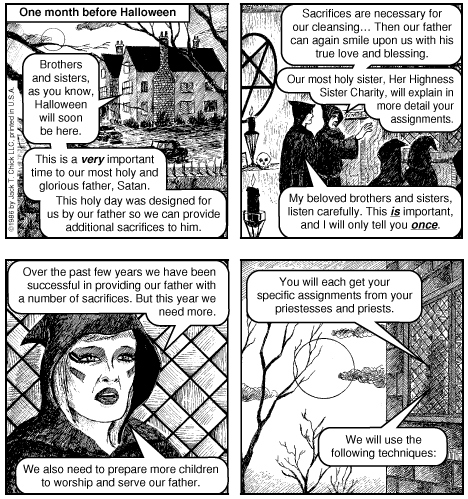 In 1989, Jack T. Chick published a comic strip gospel tract that claimed to reveal the truth behind Halloween: the panels reveal a group of Satan-worshipers gathering in the weeks before Halloween to “provide our father [the devil] with a number of sacrifices.” They plan to murder some children (“in order to obtain more blood for our master”) by tainting the candy with “razor blades, crushed glass, pins, etc.” while bringing other children under Satan’s “guidance and care” by performing incantations over the candy that, when consumed, will cause children who were once “so sweet” to become “totally rebellious”–refusing to go to Sunday school “without a big fight.”
In 1989, Jack T. Chick published a comic strip gospel tract that claimed to reveal the truth behind Halloween: the panels reveal a group of Satan-worshipers gathering in the weeks before Halloween to “provide our father [the devil] with a number of sacrifices.” They plan to murder some children (“in order to obtain more blood for our master”) by tainting the candy with “razor blades, crushed glass, pins, etc.” while bringing other children under Satan’s “guidance and care” by performing incantations over the candy that, when consumed, will cause children who were once “so sweet” to become “totally rebellious”–refusing to go to Sunday school “without a big fight.”
This tract undoubtedly represented an extreme view even among conservative Christians, but the idea of Halloween as a satanic holiday rife with the potential to harm children seems to have held considerable traction in many families, including the one in which I grew up and even after the isolated and rare instances of candy-tampering were shown to be largely mythical. (Though Snopes.com confirms that there were a few–very few–instances where children were pricked by sharp objects that had been inserted into Halloween candy.) Ministries such as John MacArthur’s “Grace to You” pointed out the Celtic pagan roots of the holiday and churches sought alternatives: hosting “harvest parties” where kids could dress up (but not as witches), bob for apples, and overload on sugar. Jerry Falwell went a step further and created the “scaremare”: a sort of haunted house that “replaced the demon-filled message of Halloween with the biblical message ‘man dies, Christ saves,’” in effect scaring people into belief.
These days, even conservative Christians seem to be a little more relaxed on the question of Halloween. Jim Daly, president of Focus on the Family admits that he and his wife “have chosen to allow our sons to engage in the innocent and harmless side of Halloween” while condemning the excessively ghoulish displays Halloween often encourages, acknowledging that Christians differ on the subject and insisting that he “respect[s] the strongly held perspectives in both camps.” At TheResurgence.com, which is closely associated with Mark Driscoll, Winfield Bevins suggests that a “Happy Christian Halloween” is possible and that it’s a bad idea for Christians to be “weird” about Halloween and refuse to participate. Over at John Piper’s website, DesiringGod.org, David Mathis makes similar suggestions, encouraging Christians to use Halloween as a chance to connect with neighbors for the sake of the gospel.
Concerns over the pagan roots of the holiday and the fear of tainted candy may have taken a backseat for most Christians, but it’s possible that other things should concern us about Halloween..